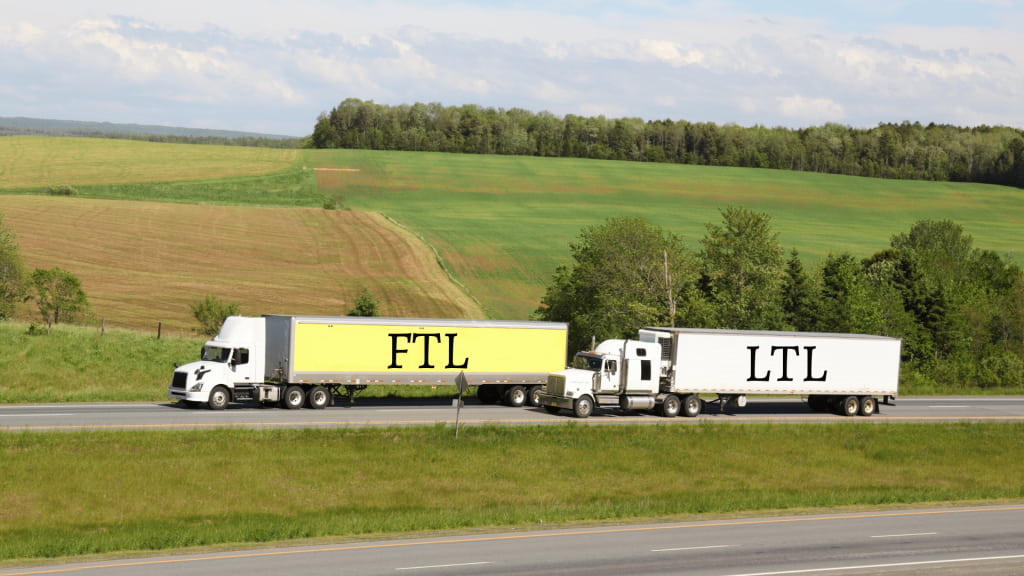Regarding shipping freight, there are several alternatives to choose from. Each type of transportation can be beneficial. However, it depends on your business objectives, variety of cargo, dimensions, and a few other factors for which transportation method you should use. Shippers often hesitate between FTL vs. LTL shipping modes; we’ll clarify this for you.
What is the difference between FTL and LTL shipping?

The main difference between full truckload and less-than-truckload freight shipping mode is that FTL fills an entire trailer with your freight. Therefore you pay for the whole truck capacity, while LTL has multiple shipments combined in one trailer. So, LTL lets you pay for the space your freight uses in the trailer.
FTL shipping and LTL shipping are priced differently. Truckload freight rates are calculated primarily on weight, dimensions, lane, and additional factors, while LTL pricing highly depends on freight classification. This classification is based on a shipment’s density, so different commodity types can have a significant cost difference.
In terms of shipping speed, full truckload often appears faster than LTL because of fewer stops during transit. FTL shipping involves less freight handling, making it safer than less-than-truckload. It’s critical to consider how strict are your delivery deadlines. You can confidently book an LTL shipment if a minor delay is not a problem.
What are transportation modes?
Before diving into the diverse world of freight shipping, you should get acquainted with the two primary transportation modes: full truckload (FTL) and less-than-truckload (LTL). If you are unfamiliar with the two, you might ask how FTL vs. LTL work and which one will work better for you.
The transportation mode you choose determines the type of vehicle, delivery speed, and price of the shipping services. It’s vital to consider a suitable transportation mode relying on your cargo characteristics and delivery deadlines. Besides, your logistics budget plays an essential role in this process. Below, we’ll describe the differences between FTL vs. LTL shipping in detail.
What is full truckload (FTL) shipping?
Truckload shipping means your freight fills the entire capacity of a truck’s trailer or a significant part. According to statistics, full truckload shipping is the most frequent transportation mode for businesses on a larger scale. In 2021, the market size of the truckload industry reached over $212 billion. Carriers mostly move alike freight for large enterprises, suppliers, and retailers.
What is less-than-truckload (LTL) shipping?
Unlike truckload shipping, less-than-truckload shipping means you partially use the trailer space and share the overall load cost with other shippers. The LTL market is small compared to different shipping modes. However, it is popular among small businesses and individual shippers. This method offers much more flexibility and other benefits for small shippers. Besides, LTL shipping offers higher carrier capacity, which can be beneficial in the case of spot shipments.
When to use full truckload shipping?
Full truckload shipping is a fast and reliable way to ship large amounts of freight. Truckload shipping will work for you if:
- You have enough goods to fill in the entire trailer space (from 15,000 to 50,000 pounds)
- You have tight shipping deadlines
- You want a truck dedicated just to your load
- You need to ship large items of high volume
FTL shipping can be more expensive than LTL, but if you ship large volumes of freight, sometimes it’s more cost-efficient to choose FTL. Truckload shipping also requires less handling. It increases the chances of your load having an accurate transit time and fewer chances for delay and shipment damage.
When to use LTL shipping?
Less-than-truckload is an affordable and flexible shipping solution. It offers many benefits for shippers who move larger than parcel items and small businesses with a small volume of freight. LTL shipping will work for you if:
- You have a small volume of cargo that doesn’t fill the entire trailer (the weight of your shipment is less than 20,000 lbs)
- You’re searching for a cost-efficient shipping option
- You’re not very tight on the delivery time
- You’re looking for a capacity for a spontaneous shipment
FTL and LTL shipping with GoShip
To sum up, truckload and LTL transportation modes can be beneficial. However, it depends on many factors: freight volume, your budget, shipping frequency, and time frames. Either way, both full truckload and less-than-truckload shipping can be excellent options for your shipment.
At GoShip, we are ready to help you choose a suitable transportation mode that responds to your shipping needs. With the necessary information about your cargo, we’ll be able to create a tailored shipping experience and deliver your items safely and timely. Visit our website to compare carrier prices and get a free quote!